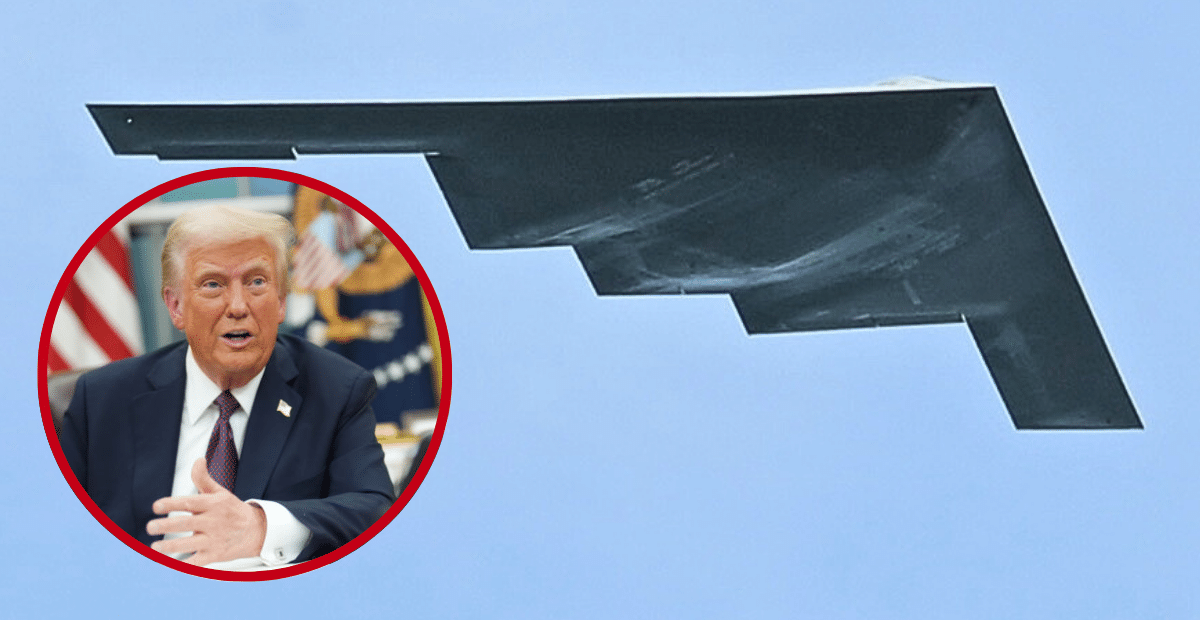U.S. Bombs 3 Iranian Nuclear Sites, Calls For Iran To End War With Israel
on Jun 21, 2025

Trump Urges “Now Is The Time For Peace” After Bombing Iran’s Nuclear Sites
After several days of tension between the United States and Iran, President Donald Trump shared on Saturday, June 21, that a “very successful attack on the three Nuclear sites” had been conducted by the United States.
Targeting nuclear sites in the Iranian cities of Fordow, Natanz, and Esfahan, with Trump noting a “full payload of BOMBS was dropped on the primary site, Fordow,” Trump declared on social media, “NOW IS THE TIME FOR PEACE!”
Trump added, “All planes are safely on their way home. Congratulations to our great American Warriors. There is not another military in the World that could have done this.”
"We have completed our very successful attack on the three Nuclear sites in Iran, including Fordow, Natanz, and Esfahan. All planes are now outside of Iran air space. A full payload of BOMBS was dropped on the primary site, Fordow. All planes are safely on their way home.… pic.twitter.com/AqCLmaLYJb
— The White House (@WhiteHouse) June 21, 2025
Speaking from the White House on June 21, Trump said, “Our objective was the destruction of Iran’s nuclear enrichment capacity and a stop to the nuclear threat posed by the world’s No. 1 state-sponsor of terror.”
He added, “Tonight, I can report to the world, that the strikes were a spectacular military success.”
Continuing, he said, “Iran’s key nuclear enrichment facilities have been completely and totally obliterated.”
From there, Trump described Iran as “the bully of the Middle East,” saying the Islamic republic “must make peace.”
Watch Trump’s full remarks, here:
This comes just over a week since Israel’s surprise attack against Iran on June 13, which saw Iran retaliate against the Jewish state and its “Rising Lion” operation.
At the time of the surprise attack, the United States’ imposed 60-day deadline for Iran to lessen its nuclear program had been crossed.
“We knew just about everything,” President Donald Trump told the press on June 14. “We knew enough that we gave Iran 60 days to make a deal and today is 61, right?”
By June 17, Trump announced on Truth Social that the United States had “complete and total control of the skies over Iran.”
He went on to share, in a separate post, the following:

Then called for the “UNCONDITIONAL SURRENDER” of Iran in another post that day.
All of this had many, on the right and left of the political spectrum, speculating what Trump’s course of action would be, if any, against the Islamic republic.
If the U.S. military were to be engaged in combat against Iran, many noted it would be contrary to Trump’s campaign promise of “no new wars.”
Timeline Leading Up To Bombing
Much of the current conflict in the region goes back to the actions of one of Iran’s regional allies: Palestine.
Hamas’ terrorist attack against Israel on October 7, 2023, saw 1,195 people killed and 251 hostages taken, and Israel responded with a full invasion of Gaza on October, 27, 2023.
This war has seen Israel take fire from Hezbollah in Lebanon, Houthi rebels in Yemen, the Islamic Resistance in Iraq, and — most significantly — Iran.
On April 13, 2024, Iran launched 170 drones, 30 cruise missiles, and 120 ballistic missiles at Israel, with most of the attack being intercepted by Israel’s Iron Dome defense system.
Iran then fired 200 more ballistic missiles against Israel on October 1, 2024.
Leading up to the June 13 surprise attack made by Israel against Iran, the United States began permitting dependents of military personnel in the Middle East to evacuate the region on June 11.
The Israel-Iran War formally began on June 13 when Israel attacked Iran by surprise, “deploying warplanes and drones previously smuggled into the country to assault key facilities and kill top generals and scientists,” AP News reported.
Among those killed in the attack was the head of the Islamic Revolutionary Guard Corps, Major General Hossein Salami.
After the first day of the G7 Summit in Canada, Trump left early on June 16, claiming his departure had “nothing to do with a ceasefire,” instead stating it was regarding something “much bigger than that.”
That day, Trump posted on Truth Social, saying, “Iran should have signed the ‘deal’ I told them to sign. What a shame, and waste of human life. Simply stated, IRAN CAN NOT HAVE A NUCLEAR WEAPON. I said it over and over again! Everyone should immediately evacuate Tehran!”
Traffic from people evacuating Tehran that night was backed up for hours, and, by June 17, the U.S. was reporting its control of Iranian airspace.
Starting on June 20, Trump gave Iran two weeks to negotiate a deal, but, on June 21, Israel intercepted more missiles from Iran.
“No New Wars”
Many have responded to the tension between the United States and Iran as a departure from Trump’s campaign promise of “no new wars.”
Still, Trump’s June 21 post indicates he views the bombing of the Iranian nuclear sites as a measure to maintain peace, with “peace through strength” being another Trump mantra.
Within his own cabinet, eyes have been on Director of National Intelligence Tulsi Gabbard, who testified before the Senate Intelligence Committee on March 25 that Iran was not developing nuclear weapons.
There, Gabbard said:
“Iran continues to seek expansion of its influence in the Middle East … The [Intelligence Community] continues to assess that Iran is not building a nuclear weapon and Supreme Leader Khamanei has not authorized the nuclear weapons program he suspended in 2003 … In the past year, we have seen an erosion of a decades-long taboo in Iran on discussing nuclear weapons in public, likely emboldening nuclear weapons advocates within Iran’s decision-making apparatus. Iran’s enriched uranium stockpile is at its highest levels and is unprecedented for a state without nuclear weapons.”
She went on report that Iran’s “Axis of Resistance” — made up of a variety of its allies and terrorist organizations — “still presents a wide range of threats, including to Israel’s population, U.S. forces deployed in Iraq and Syria, and to U.S. and international military and commercial shipping and transit.”
When asked aboard Air Force One on June 17 what he thought of Gabbard’s assessment of Iran back in March, Trump replied, “I don’t care what she said. I think that [Iran] is very close to having [a nuclear weapon].”
This comment came about one day after Trump posted, largely in response to Tucker Carlson, the following:

Speaking to Fox News Digital, Vice President JD Vance said of Gabbard, “Tulsi Gabbard is a veteran, a patriot, a loyal supporter of President Trump, and a critical part of the coalition he built in 2024. She’s an essential member of our national security team, and we’re grateful for her tireless work to keep America safe from foreign threats.”
In a June 17 statement posted on X, formerly Twitter, Vance wrote, “Look, I’m seeing this from the inside, and am admittedly biased towards our president (and my friend), but there’s a lot of crazy stuff on social media, so I wanted to address some things directly on the Iran issue.”
Stating that Trump “has been amazingly consistent, over 10 years, that Iran cannot have a nuclear weapon,” Vance said:
“Over the last few months, he encouraged his foreign policy team to reach a deal with the Iranians to accomplish this goal. The president has made clear that Iran cannot have uranium enrichment. And he said repeatedly that this would happen one of two ways–the easy way or the ‘other’ way.”
Adding that “Iran could have civilian nuclear power without enrichment,” he noted that “Iran rejected that” offer. “Meanwhile, they’ve enriched uranium far above the level necessary for any civilian purpose.”
He went on to say:
“The president has shown remarkable restraint in keeping our military’s focus on protecting our troops and protecting our citizens.”
Concluding his post, he said, “People are right to be worried about foreign entanglement after the last 25 years of idiotic foreign policy. But I believe the president has earned some trust on this issue. And having seen this up close and personal, I can assure you that he is only interested in using the American military to accomplish the American people’s goals. Whatever he does, that is his focus.“
Since then, Gabbard posted on X on June 20:
The dishonest media is intentionally taking my testimony out of context and spreading fake news as a way to manufacture division. America has intelligence that Iran is at the point that it can produce a nuclear weapon within weeks to months, if they decide to finalize the assembly. President Trump has been clear that can’t happen, and I agree.












